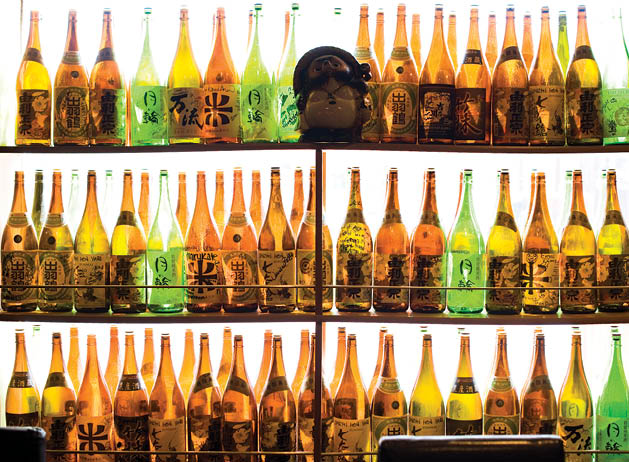Walking into Red Lantern in White Bear Lake is a bit mysterious: Cloaked in low light, with red hues emanating from the three lanterns that overhang the horseshoe-shaped sushi bar, the space is small, cozy, warm—a far cry from the brick and wood-paneled exterior. The windows are filled with empty oversized sake bottles of various vintage. With a total of 36 seats in the entire space, reservations are a must any time of year, particularly on weekends.
That’s just as chef and owner Wei Wang intends it. With 26 years in the sushi business, and even more in the food industry in general, he and chef Jordan Wolterstorff have the know-how to do authentic Japanese fish presentation right.
On most nights, investing partner Wolterstorff maintains his place behind the front bar, while Wang covers the kitchen, but true to Japanese tradition, he doesn’t stay back there for long—all staff take turns running plates to the tables or busing dishes back-of-house. “Each chef delivers his own plate,” Wang says, “because a chef knows his own dish best. Whoever made it is the person to answer customers’ questions.”
Wang, who emigrated from Japan at age 10, first tested his cooking chops cutting vegetables and doing prep in the back of his parents’ Lake Geneva, Wis., restaurant at age 13. But it wasn’t until college in 1995 at the University of Minnesota that he had the opportunity to study under a 25-year veteran sushi master at Sakura, which led to gigs as head sushi chef there, at Crave and ultimately a partnership at the head of Fuji Ya, where Wolterstorff apprenticed under him for five years.
Open since December 2013, Aka Chouchin (“Red Lantern” in Japanese) originally was intended to be an izakaya, or a bar with food available, but Wang says it quickly was apparent that what White Bear Lake wanted was the sushi. “Our menu is only going to be what we can fit on that one piece of paper,” Wang says. “Everything we do is from scratch.”
Let’s talk about the fish: Regulars rave about the freshest they’ve found in the Twin Cities, which comes from chef Wang’s connections around the globe, including Japan and Hawaii, as well as shops in the continental U.S. “In the Japanese world, relationship is huge. I know every fish purveyor I work with personally,” Wang says. “So they know when they get a big chunk of fish, they save some for me—they know what I prefer.”
Wang has seafood flown in several times a week and never buys more than he’ll use that day, ensuring top-notch seasonal and sustainable fare. “That’s the key to our freshness,” he says. For example, the restaurant uses only wild-caught white shrimp, “even for our tempuras,” he notes.



Specialties are a matter of who you are talking to: “The torch roll is definitely a favorite,” server Ellen Odmark says, of spicy salmon and tempura asparagus rolled in hamachi (yellowtail) and spicy aioli ($25), which is then literally set aflame to melt down into the roll. It’s topped with fresh lemon zest, combining simple flavors that add a diversity of textures, thanks to the torching.
But the best-kept secret is Wolterstorff’s margarita roll ($25), which incorporates finely cut lime and rock salt atop tempura shrimp, tuna and avocados. It’s drizzled with a simple syrup derived from his homemade tequila.
“Really, we try not to put names on our rolls,” Wang says, “because once it’s got a name, then it’s a cuisine that doesn’t exist in Japan. It becomes American sushi; we want any Japanese customer to come in and know this is authentic sushi.”
For sushi novices, the California roll (crab, asparagus and carrots; $8) or the hosomaki (a single-food roll that can be as simple as cucumber wrapped in seaweed and rice; $6) are advisable, along with some of the safer a la carte offerings such as potstickers ($10) or the off-menu fried rice with bacon, scallions and fresh white shrimp ($8); keep in mind that options change seasonally. House rolls (eight to 10 large pieces for $25) always include the “chef’s choice” omakase roll and the futo, meaning “fat,” roll, a combination of all the different fish in stock that night in one large roll, which offers a different flavor experience in every bite.
It goes without saying that a chef who has the luxury of shopping for the day will have seasonal fare—even if sometimes he runs out if an unexpected rush comes in.
“You don’t realize what great food can come out of” an eatery with such an unassuming exterior, first-time customer Becca Darrow says. “I’d like to keep this place a secret,” she adds with a laugh. “It’s like a sushi speakeasy.”
Speaking of speakeasies, the adult beverages are a diverse combination of traditional Japanese sakes and beers, and the Big Wood Brewery craft beer that our hometown brewer has become known for.
When it comes to the craft of sushi-making, Wang says he doesn’t even consider himself a chef anymore, because there’s so much minutiae, so many details to keep track of in his chosen cuisine. He’s too busy running the business.
“Sushi-making is so simple that it’s hard—I mean, there’s no cooking involved, right?” Wang says. “But let’s just take one fish—tuna, for example. Just learning about the different species, the season, that’s a bunch of information in itself. Then it’s the cutting of the tuna, which is all about knife skills. It’s in all those microscopic details, that’s where the trade and the art come in. Some people really appreciate it—and some people just want to eat it.”
Both sushi-loving types are welcome at Red Lantern, and both will be favored with an “Arigato” (“Thank you”) as they leave for the night.

Sushi Glossary: Your guide to better understanding the Japanese delicacy
(clockwise from top)
Maki: The most basic of sushi rolls, with seaweed on the outside. The word means “roll” in Japanese. Common maki include hosomaki, which is a slim roll, often with just one other ingredient beyond the rice; another is futomaki, or fat rolls, which incorporate multiple ingredients
Shari: A special sushi rice that is round, short-grain white rice that is especially sticky and plump when steamed
Nigiri: Sliced raw fish over—not rolled with—pressed vinegar rice
Nori sheet (aka laver): A paper-like, edible toasted seaweed; the part that holds the sushi roll together
Bamboo mat: Required for rolling proper sushi
(other helpful terms)
Aka Chouchin: “Red lantern” in Japanese
Izakaya: A
type of Japanese drinking establishment that also serves food to
accompany the drinks. Red Lantern has a small-plate menu that changes
seasonally
Sashimi: Thinly sliced raw meat, usually fish such as salmon or tuna, served without rice. It is sometimes confused with sushi
Sushi: The combination of vinegar rice with meats and veggies that sometimes include sashimi
Sushi-Grade Sushi: Paramount to any make-your-own; be sure to ask at the grocery counter to ensure your fish is safe to eat raw
Sushi-su: The sauce that adheres the rice, making it sticky
Tempura: A Japanese dish of seafood or veggies that have been battered and deep-fried
Interested in making your own sushi?
Sushi 101: A do-it-yourself approach to rice, rolls and everything in between
Red Lantern chef/owner Wei Wang once considered offering sushi classes in White Bear Lake; he’s offered apprenticeships to countless sushi pros through his years as head chef at Fuji-ya, Sakura and Crave in St. Paul and Minneapolis, and as a corporate chef for OTG, a company that specializes in opening restaurants in airports. He’s taught sushi basics at Kitchen Window on numerous occasions. But it’s not where he’s going with Red Lantern.
“We were thinking about it, but decided that’s just a different sector,” he says. “We’re open to doing [a private class] at someone’s home, but we’ll not have an event at the bar—it just feels like something different than what we have become.”
You can still benefit from his years of experience, though, with these pointers we’ve compiled here.
- Make your shari: Rinse the rice with running water for 1–2 minutes until the water drains clear. (One cup of shari makes three rolls.) Place cleaned rice in a pot, and follow package instructions. Hint: Rice cookers do wonders for perfect consistency and stickiness; the ratio of water to rice should be about 1.5:1. This process could take 6–10 minutes after water boils.
- While rice cooks, wash and cut the veggies. Hint: An extremely sharp knife is essential for this step as well as slicing sushi rolls. Cut the carrots in half length-wise, then cut them into long skinny strips. Repeat on the cucumber, avocado and any other veggie you choose to incorporate.
- Make the sushi-su: For 3 cups of uncooked rice, use ½ cup of rice vinegar, 2 Tbsp. sugar and 2 tsp. salt. Mix over medium heat until all solids are incorporated. Note: Only use rice vinegar; do not use any other kind.
- Remove the rice: Only use a wooden spoon to handle the delicate cooked rice; this also avoids metal interactions with the vinegar that will be added later. Don’t scrape the rice from the bottom of the pot; it’s dry and possibly burned. Use a wooden or plastic bowl.
- Combine sushi-su and shari; stir well, then place rice in a cool space, but do not refrigerate (this can ruin the rice). Hint: Apply sushi-su sparingly at first; sometimes the flavor is harsh for sushi-newbies.
- Lay out the nori on your bamboo mat, rough-side up. Using a piece of plastic wrap between the bamboo and nori will help keep things from sticking.
- You can find nori in most Asian markets. Hint: Nori sheets are hard to store after opening because they must be kept dry; buy the packs of 10 sheets rather than 50- or 100-count packs.
- Get your hands wet, and gently take about a handful of rice, forming a loose ball. Hint: Keep a water bowl handy while working with sushi rice because it’s sticky, but have a dry towel on hand for when working with the nori.
- Gently put the rice ball in the middle of the nori sheet and start spreading it equally, creating a layer of rice covering almost the entire sheet except the upper edge of nori (the edge furthest from you), which should be kept uncovered to help fuse together the roll once it’s wrapped up. Be careful not to compress the rice!
- Time to fill your roll—the ingredients are varied and completely up to you. Start with the sushi-grade fish; place on nori edge closest to you. Add a slice or two of vegetables.
- Using the closer edge of the rolling mat, wrap one entire roll of the filling with the nori, making an almost-rectangular hill; gently tighten the roll, lightly pressing down on the roll from the center with both hands working outward.
- Continue rolling with help from the bamboo—roll the nori one rotation, then use the bamboo to gently compress—keeping the roll tight with every move until you reach the end of the nori. Be careful not to squeeze out the filling, but apply consistent pressure throughout the process on all surfaces of the roll.
- Use a wet, sharp knife to cut the roll into sushi units, generally six to eight per roll.









